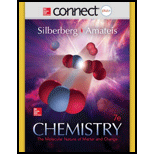
(a)
Interpretation:
Three different flasks that contain
Concept introduction:
The ideal gas equation can be expressed as follows:
Here,
The expression to calculate the moles of gas is as follows:
(b)
Interpretation:
Three different flasks that contain
Concept introduction:
The expression to calculate the average kinetic energy of gases is as follows:
Here,
The expression to calculate the kinetic energy is as follows:
The kinetic energy is directly proportional to the temperature.
(c)
Interpretation:
Three different flasks that contain
Concept introduction:
Effusion is explained as the movement of the gas molecule through a pinhole.
Diffusion can be explained as the mixing of one gas molecule with another gas molecule by random motion.
According to Graham’s law of effusion, the rate of effusion of a gas is inversely proportional to the square root of its molar mass.
The mathematical expression of Graham’s law of effusion is as follows:
Here,
(d)
Interpretation:
Three different flasks that contain
Concept introduction:
The expression to calculate the root-mean-square speed is as follows:
Here,
The expression to calculate the average kinetic energy of gases is as follows:
Here,
The expression to calculate the kinetic energy is as follows:
The kinetic energy is directly proportional to the temperature.
(e)
Interpretation:
Three different flasks that contain
Concept introduction:
The expression to calculate the density of the air is as follows,
Here,
Rate of diffusion is inversely proportional to the square root of the density of the gas.
The expression to calculate the density of a gas is as follows:
(f)
Interpretation:
Three different flasks that contain
Concept introduction:
The mean free path can be defined as the average distance traveled by the gas molecule during a collision. There are many factors that affect the mean free path such as pressure, temperature, density and radius of the molecule.
The collision frequency is defined as the ratio of the most probable speed to the mean free path.
Want to see the full answer?
Check out a sample textbook solution
Chapter 5 Solutions
Connect 2-Year Access Card for Chemistry: The Molecular Nature of Matter and Change
- Identify any polar covalent bonds in epichlorohydrin with S+ and 8- symbols in the appropriate locations. Choose the correct answer below. Η H's+ 6Η Η Η Η Η Ηδ Η Ο Ο HH +Η Η +Η Η Η -8+ CIarrow_forwardH H:O::::H H H HH H::O:D:D:H HH HH H:O:D:D:H .. HH H:O:D:D:H H H Select the correct Lewis dot structure for the following compound: CH3CH2OHarrow_forwardRank the following compounds in order of decreasing boiling point. ннннн -С-С-Н . н-с- ННННН H ΗΤΗ НННН TTTĪ н-с-с-с-с-о-н НННН НН C' Н н-с-с-с-с-н НН || Ш НННН H-C-C-C-C-N-H ННННН IVarrow_forward
- Rank the following compounds in order of decreasing dipole moment. |>||>||| ||>|||>| |>|||>|| |||>||>| O ||>>||| H F H F H c=c || H c=c F F IIIarrow_forwardchoose the description that best describes the geometry for the following charged species ch3-arrow_forwardWhy isn't the ketone in this compound converted to an acetal or hemiacetal by the alcohol and acid?arrow_forward
- What is the approximate bond angle around the nitrogen atom? HNH H Harrow_forwardOH 1. NaOCH2CH3 Q 2. CH3CH2Br (1 equiv) H3O+ Select to Draw 1. NaOCH2 CH3 2. CH3Br (1 equiv) heat Select to Edit Select to Drawarrow_forwardComplete and balance the following half-reaction in acidic solution. Be sure to include the proper phases for all species within the reaction. S₂O₃²⁻(aq) → S₄O₆²⁻(aq)arrow_forward
- Q Select to Edit NH3 (CH3)2CHCI (1 equiv) AICI 3 Select to Draw cat. H2SO4 SO3 (1 equiv) HO SOCl2 pyridine Select to Edit >arrow_forwardComplete and balance the following half-reaction in basic solution. Be sure to include the proper phases for all species within the reaction. Zn(s) → Zn(OH)₄²⁻(aq)arrow_forwardb. ὋΗ CH3CH2OH H2SO4arrow_forward
 ChemistryChemistryISBN:9781305957404Author:Steven S. Zumdahl, Susan A. Zumdahl, Donald J. DeCostePublisher:Cengage Learning
ChemistryChemistryISBN:9781305957404Author:Steven S. Zumdahl, Susan A. Zumdahl, Donald J. DeCostePublisher:Cengage Learning ChemistryChemistryISBN:9781259911156Author:Raymond Chang Dr., Jason Overby ProfessorPublisher:McGraw-Hill Education
ChemistryChemistryISBN:9781259911156Author:Raymond Chang Dr., Jason Overby ProfessorPublisher:McGraw-Hill Education Principles of Instrumental AnalysisChemistryISBN:9781305577213Author:Douglas A. Skoog, F. James Holler, Stanley R. CrouchPublisher:Cengage Learning
Principles of Instrumental AnalysisChemistryISBN:9781305577213Author:Douglas A. Skoog, F. James Holler, Stanley R. CrouchPublisher:Cengage Learning Organic ChemistryChemistryISBN:9780078021558Author:Janice Gorzynski Smith Dr.Publisher:McGraw-Hill Education
Organic ChemistryChemistryISBN:9780078021558Author:Janice Gorzynski Smith Dr.Publisher:McGraw-Hill Education Chemistry: Principles and ReactionsChemistryISBN:9781305079373Author:William L. Masterton, Cecile N. HurleyPublisher:Cengage Learning
Chemistry: Principles and ReactionsChemistryISBN:9781305079373Author:William L. Masterton, Cecile N. HurleyPublisher:Cengage Learning Elementary Principles of Chemical Processes, Bind...ChemistryISBN:9781118431221Author:Richard M. Felder, Ronald W. Rousseau, Lisa G. BullardPublisher:WILEY
Elementary Principles of Chemical Processes, Bind...ChemistryISBN:9781118431221Author:Richard M. Felder, Ronald W. Rousseau, Lisa G. BullardPublisher:WILEY





